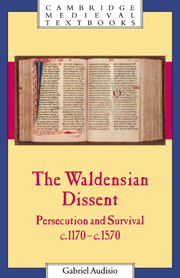Book contents
- Frontmatter
- Contents
- List of maps
- Preface
- Acknowledgements
- Introduction
- 1 1170 – 1215: decisive and purposive origins
- 2 The thirteenth century: the need to adapt
- 3 The fourteenth century: the challenge of believing differently
- 4 The fifteenth century: the risks of longevity
- 5 The constraints of a life in hiding
- 6 The need to organise
- 7 A culture of their own: the written and the spoken word
- 8 The sixteenth century: the end as a way forward?
- 9 Epilogue: the Waldensian Church
- Conclusion
- Bibilography
- Index
- Cambridge Medieval Textbooks
3 - The fourteenth century: the challenge of believing differently
Published online by Cambridge University Press: 05 June 2012
- Frontmatter
- Contents
- List of maps
- Preface
- Acknowledgements
- Introduction
- 1 1170 – 1215: decisive and purposive origins
- 2 The thirteenth century: the need to adapt
- 3 The fourteenth century: the challenge of believing differently
- 4 The fifteenth century: the risks of longevity
- 5 The constraints of a life in hiding
- 6 The need to organise
- 7 A culture of their own: the written and the spoken word
- 8 The sixteenth century: the end as a way forward?
- 9 Epilogue: the Waldensian Church
- Conclusion
- Bibilography
- Index
- Cambridge Medieval Textbooks
Summary
The wealth of documentation from the fourteenth century is, for the most part, available to us due to the fact that the Inquisition was being stepped up. It has already been stated that there remains only one document from the era issuing directly from the Poor of Lyons themselves, this being the exchange of letters between the Lombard and Austrian Brothers dating from about 1368. Other than this, the mass of documents consists of polemical treatises, and manuals of inquisitorial procedures and trials. Jacques Fourmer, to whom we referred in the previous chapter, the bishop of Pamiers and the future pope Benedict XII, led proceedings in the south of France between 1318 and 1325, at the same time as the Dominican inquisitor Bernard Gui. In northern Italy, the Inquisition led by Albert of Castellano was set up in Giaveno in 1335, while in the same region of the Alps, Thomas of Casaco led the trials in the Lanzo valleys in 1373 and Antony of Settimo led those in western Piedmont in 1387. On a much larger scale were the proceedings led by Henry of Olomouc in Styna between 1360 and 1370 – which prompted the exchange of letters between the Italian and Austrian Brothers in 1368 – and especially those headed by Gallus of Neuhaus, another Dominican inquisitor, who led a ruthless campaign in Bohemia for twenty years, from 1335 to 1355.
- Type
- Chapter
- Information
- The Waldensian DissentPersecution and Survival, c.1170–c.1570, pp. 40 - 59Publisher: Cambridge University PressPrint publication year: 1999

